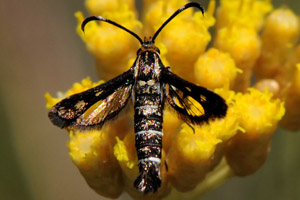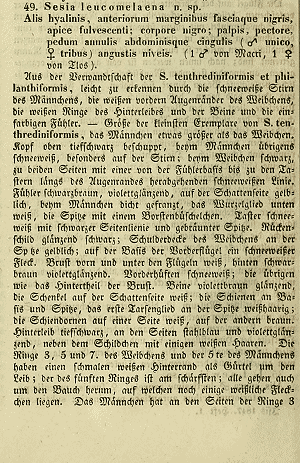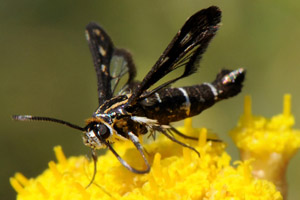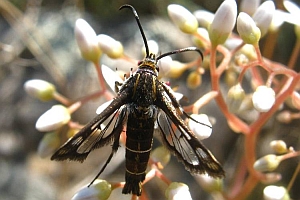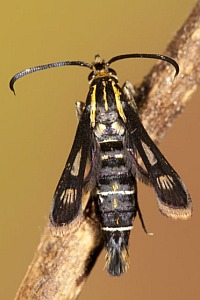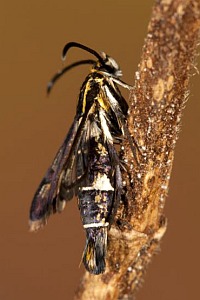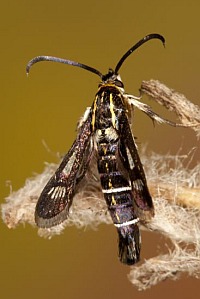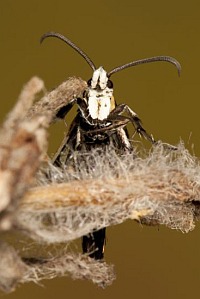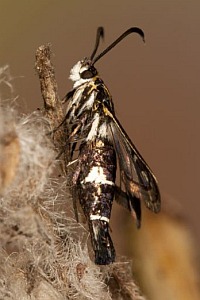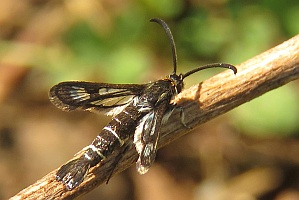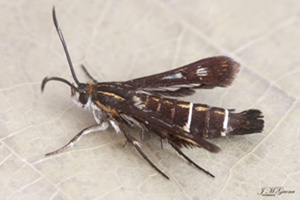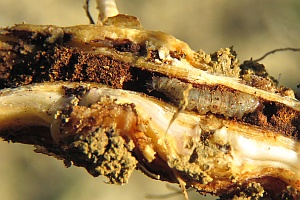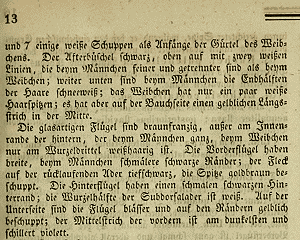

 +19Kontinente:EUAS
+19Kontinente:EUAS1. Lebendfotos
1.1. Falter
1.2. Raupe
1.3. Puppe, Exuvie
2. Diagnose
2.1. Erstbeschreibung
3. Biologie
3.1. Habitat
3.2. Raupennahrungspflanzen
3.3. Nahrung der Raupe
- [Rosaceae:] Sanguisorba minor (Kleiner Wiesenknopf)
- [Geraniaceae:] Geranium sanguineum ? (Blut-Storchschnabel ?)
Innerhalb der Gattung Pyropteron fällt P. leucomelaena durch die Nahrungspflanze seiner Raupe ganz aus dem Rahmen. Während die meisten Species Rumex-Arten nutzen, andere Geraniaceae, Cistaceae oder Plumbaginaceae, ist P. leucomelaena die einzige, die in Wurzeln von Rosaceen - hier dem Kleinen Wiesenknopf (Sanguisorma minor agg.) - lebt. Nach Bartsch et al. (2021: 39-40) gilt das sowohl für die nominotypische Unterart im Westen (Frankreich) wie im Osten (Griechenland, Zypern) des Verbreitungsgebiets, als auch für die ssp. blaesii in Südspanien und Nordafrika (Marokko); dennoch gibt es ein Aber: "The hostplant for both subspecies is Sanguisorba minor Scopoli (Rosaceae) (Tosevski 1986, and our own observation). We have bred the species from this hostplant both in the western and eastern part of its range. Notably, however, in Morocco the species is sometimes very abundant in places where Sanguisorba is not present. Thus, other hostplants are likely to play an important role. Laštůvka & Laštůvka (2001) also reported oviposition on Geranium sanguineum Linnaeus (Geraniaceae) in Sicily." Letzteres ist die Raupennahrung der nächsten verwandten Arten, Pyropteron kautzi und Pyropteron aistleitneri wie auch einiger weiterer Arten der Gattung Pyropteron.
4. Weitere Informationen
4.1. Etymologie (Namenserklärung)
„λευχός weiß, μελάς schwarz.“
4.2. Andere Kombinationen
- Sesia leucomelaena Zeller, 1847 [Originalkombination]
- Synansphecia leucomelaena (Zeller, 1847)
4.3. Synonyme
- Sesia therevaeformis Lederer, 1853
- Synansphecia luccomelaena Minà-Palumbo & Failla-Tedaldi, 1889
- Sesia cretica Rebel, 1916
4.4. Unterarten
- Pyropteron leucomelaena blaesii Bartsch, Pühringer, Lingenhöle, & Kallies, 2021 [Südspanien, Nordafrika]
4.5. Faunistik
Bartsch et al. (2021: 39-40) erläutern: "The typical subspecies is known from southern France in the west across southern Europe to Turkey in the east. It also occurs on the Mediterranean islands of Corsica, Sardinia, Sicily, Crete and Cyprus (Laštůvka & Laštůvka 1995, 2001, Špatenka et al. 1999). [...] Specimens from central and northern Spain are here provisionally assigned to the typical subspecies; however, more detailed analyses are needed to map the precise distribution of the two subspecies of P. leucomelaena in the Iberian Peninsula." Und zur ssp. blaesii ist zu erfahren: "Currently known from Morocco and southern Spain. Laštůvka & Laštůvka (1995, 2001) and Špatenka et al. (1999) also mention Algeria and Tunisia, which is likely to relate to P. leucomelaena blaesii ssp. nov. The geographical delimitation to the nominate subspecies in south-western Europe is still insufficiently known." Das Problem ist hier, dass sich die nordafrikanischen Tiere äußerlich meist von den europäischen Tieren unterscheiden lassen, dass genetisch der nordafrikanischen Unterart zuzuordnende Tiere aus Südspanien aber wie nominotypische Exemplare aussehen.
(Autor: Erwin Rennwald)
4.6. Literatur
- Bartsch, D., Pühringer, F., Milla, L., Lingenhöle, A. & A. Kallies (2021): A molecular phylogeny and revision of the genus Pyropteron Newman, 1832 (Lepidoptera, Sesiidae) reveals unexpected diversity and frequent hostplant switch as a driver of speciation. — Zootaxa 4972: 1-75.
- Beschreibung als Sesia cretica: Rebel, H. (1916): Die Lepidopterenfauna Kretas. — Annalen des Naturhistorischen Museums Wien 30: 66-172, pl. IV.
- Whitebread, S., Bartsch, D., Blöchinger, H., Bryner, R., Guenin, R., Hirschi, W., Pühringer, F., Sauter, W., Schmid, J. & P. Sonderegger (2000): Synansphecia leucomelaena. — In: Pro Natura – Schweizerischer Bund für Naturschutz (Hrsg.) (2000): Schmetterlinge und ihre Lebensräume. Arten, Gefährdung, Schutz. Schweiz und angrenzende Gebiete. Band 3: 234. Egg (Fotorotar AG).
- Erstbeschreibung: Zeller, P. C. (1847): Verzeichniß der von Professor Dr. Loew in der Türkey und Asien gesammelten Lepidoptera. — Isis von Oken 1847 (1): 3-39. Leipzig (Brockhaus).


















